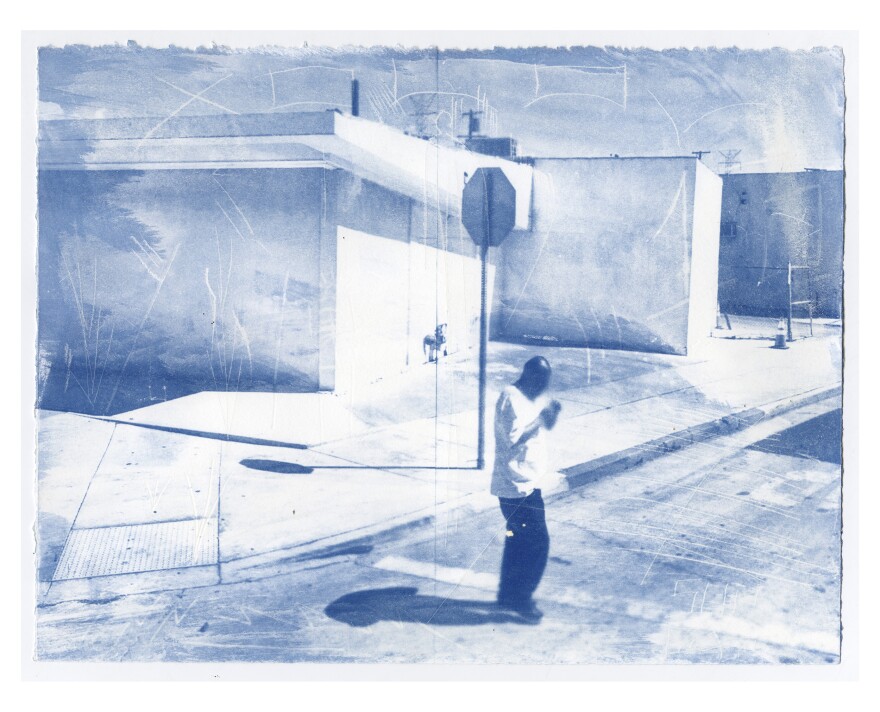The sun shines as Felix Quintana cruises through South Central Los Angeles. He's always been inspired by what he sees out of his car window, from the strip malls to the street vendors. "I love the hustle," he says. "The hand-painted signs, the swap meets, the people making money washing windshields."
But those moments can fly by. And his ongoing series of cyanotypes make us pause on the often overlooked Angelenos who work and live in the less glitzy, more gritty neighborhoods of LA County.

A multidisciplinary artist using his photographer's eye, Quintana samples from the Google Maps Street View archive, turns a screenshot into a digital negative and prints it using digital inkjet film. In the darkroom, he coats the paper with a solution and "scratches" it with symbols of the city "to reveal what's beneath the surface," he explained.
His images together re-create the act of cruising through his hometown. "Cruising is all about driving slow, hella slow, like 25 miles per hour, and bumping music and looking fresh," Quintana says. Cruising can be a political act — there are "No Cruising" signs posted in the area. "It's all about taking up space," he adds. "People are scared of all these Chicanos and black folks coming together."

The work invites you to slow down, to see black and brown people exist and resist, and to celebrate the vernacular of South Central LA in all its ungentrified glory.
"It's a very objective point of view that Google gives, but the images are still really grimy," Quintana says. "I'm able to appropriate them and reclaim them, without permission, to find the beautiful and the poetic, to frame it in a way that shows resilience."



Quintana chose the cyanotype, an alternative photographic printing process, for his love letter to his city. He makes them by exposing the cyanotype-coated paper to ultraviolet light and sunshine — the pride and joy of Los Angeles. That light develops a melancholic but brilliant blue that harkens back to architectural blueprints.
"These are the emotional and cultural blueprints of the city," Quintana says. "It's an archive of the city that's changing. When gentrification comes in, this is what you're pushing out."

In the era of pervasive horizontal wooden-slatted "flipper fences" or "gentrifences," we see chain-link fences and iron gates. Plants also persevere in this concrete jungle. Quintana draws them sprouting from the sidewalks and depicts the ubiquitous palm tree — iconic to Los Angeles even though only a single species is native to California. The motifs recall a line from rapper Tupac Shakur's poetry: "The rose that grew from the concrete."
"It's a good symbol for the people," Quintana says. "We're rooted, we're planted, we're growing."
He made these markings instinctively, he says. They feel at home in South Central LA, fluent in the local slang. "It's a very cholo, gang graffiti style — marking territories," he says.


One of his most frequently recurring drawings is a sly coyote, which has become Quintana's signature. It's a nod to artist Keith Haring's famous dog figure. "A coyote in Spanish is the person who smuggles people. That's how a lot of my family got here," Quintana says. "It's this idea of someone within the landscape, but you don't see him."


Like the coyote, the people at the center of Quintana's photographs often go unnoticed. They're working in the street, commuting without cars and shopping at the dollar store. But these images are also documentation of an inequity that affects working-class people: a lack of green space, inaccessible mass transit, food deserts.
At times, these everyday images, now extra visible, surprise even Quintana. Like the time he found his father — who died three years ago — preserved in a Google Street View image, sitting in the driver seat of his truck.
"Photography is so much about this present moment," Quintana says. "But Google has archives that date back to 2007. Now, I can make images of the past."

These images of the past preserve not just the people from Quintana's life, but the places, too. The Compton Fashion Center was an indoor flea market and West Coast hip-hop landmark with connections to Tupac, N.W.A and Kendrick Lamar. The center closed in 2015 — but it's the subject of the next entry in his continuing Los Angeles blueprints series.
"You went for CDs, white tees, vintage Nikes and Icees," Quintana said. "It's a Walmart now, which is just sad."

Felix Quintana is an artist, photographer and educator who is now based in San Jose, Calif. His Instagram is @felixfquintana.
Samantha Clark is a writer and photo editor based in Washington. Follow her on Instagram @samanthabrandyclark.
Copyright 2023 NPR. To see more, visit https://www.npr.org.



